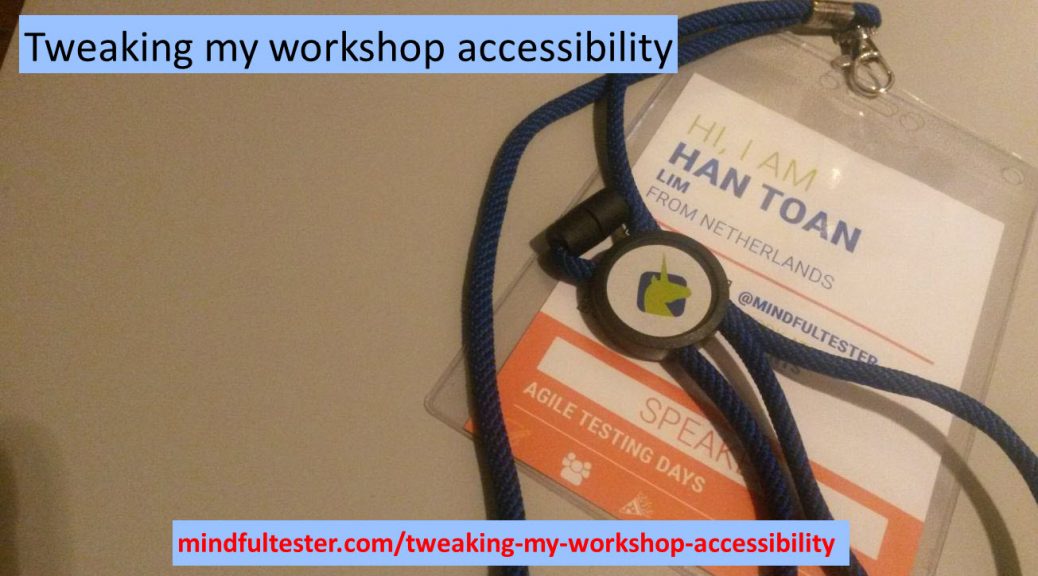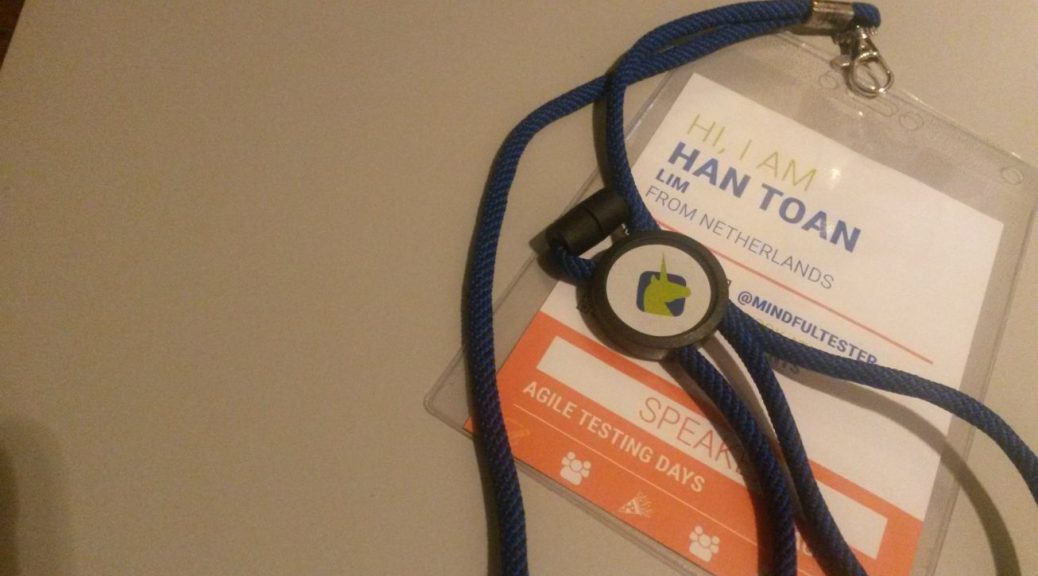During the Speakers Dinner of Agile Testing Days 2019 I told Abby Bangser about my attempts to make my workshop accessible.
“It is even possible to add alternative text to images in PowerPoint. If you click on the image, there are several tabs. One tab contains Alternative text. [ … ]
Don’t forget the exclamation mark (!). The screen reader will read it differently.”
Tobias Geyer, another speaker, was confused. I saw him thinking: “Alternative to what?”
I told him about a screen reader which could read information aloud to people. This is handy for people with a visual impairment. Alternative text is used on web sites to add more information to pictures.
If the presentation would be downloadable at the beginning of the presentation, then attendees would be able to hear the information on the slides.
Blind review
Some people state that a blind review is the best one. The reviewer is not distracted by the looks of the speaker or the beauty of the pictures.
One of my reviewers was blind, so I really needed to speak well. Without the use of my slides it was difficult to tell a story. The main feedback was no clear structure.
So I added a mind map which gave a proper view of the workshop. This was really appreciated by the next reviewer.
For the exercises I had already tested the website with a screen reader. Once again it was time for the real thing.
My blind reviewer went through the website without any delay. The reading speed was so high, that it looked like a normal person was skimming the webpages. The feedback was almost instantaneous.
It was strange for me to hear, that bugs were found by clicking around. Navigation was on hearing. My test website passed the accessibility test.
Sound advice
The Friday before Agile Testing Days I had a talk with someone with a bad hearing. I told about my workshop. How should I speak to people who cannot hear well?
“What would be your best advice?”
“Ask whether people can hear you.
It is a professional thing you can do:
“Can you hear me?”
What also helpful is, are pictures. Next to key words on the slides.” This way a talk could be reconstructed, if words would be missed.
Somehow I lost sight on my slides.
I told about the handheld microphones seen on one of the pictures. Most of the time I put it in front of my mouth.
“It can be lowered. The quality will not decrease much, but people are able to see your mouth.” Lip reading for the win.
In the days before the workshop I focused on big fonts on my slides and my cards. I increased the contrast between the text and the background.
What could go wrong?
What went wrong?
I completely forgot to ask the audience whether they could hear me. Where was my checklist?
I had none.
Oh.
The most embarrassing part of the downloadable stuff was, that there were no files on the promised location at the start of my workshop.
Big oops from my side.
After this painful discovery I repeated all the steps: I went to my github and uploaded my presentation. This time I scrolled down. A commit button?! I forgot to press it.
Github is git in the cloud. It can be used to store different versions of files. I still wrestle with it. As Janet Gregory stated in her talk it is about deliberate practice. I had only practiced once. In my case I had cut one corner too many.
Days after my workshop I checked the alternative text in the pdf file of my presentation on my laptop. I double clicked the file and the file was opened in my browser.
The text of the slide was told aloud by the screen reader. I hovered above a picture. Not a sound. I was also silent.
Last weekend I did another attempt to get some sound of a picture. I double clicked the file on my PC and Acrobat reader opened the file.
I searched a picture and placed my mouse pointer on it. A hover text was shown and read aloud. That’s what I liked to hear.
So Acrobat reader can handle alternative text of pictures, but my favourite browser not. And I had not made Acrobat reader a requisite for the workshop. A bit late, but alternative text can be used.
What went right?
I maximised pictures. Leaving out irrelevant parts from the slides.
In the right top corner of the slides I used small pictures to show the state of the test session.
During my preparation I looked at the presentation. There were no spots shining on the screen, so the contrast was good.
During the demo part I used a headset microphone. Attendees could hear me and I could talk at a normal volume. Most important is the fact, that the small microphone did not hide my mouth.

